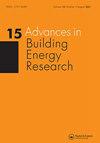Survey of energy-related occupant perceptions in a green-rated and in a non-rated building
IF 2.5
Q2 CONSTRUCTION & BUILDING TECHNOLOGY
引用次数: 4
Abstract
ABSTRACT Surveys were delivered to the occupants of two university buildings in Sydney Australia to collect occupant perceptions related with energy use and the impact of the ‘green’ rating in occupant behaviour. Overall, 100 surveys were delivered in a 6-star building, rated according to the certification system Green Star, and in a non-rated building, from Western Sydney University. Occupants were inquired about their perception and interactions with heating, cooling, lighting, windows/doors opening, windows blinds and plug loads. This made possible to understand if there is a significant difference in energy-related occupant behaviour when comparing a green-rated to a non-green-rated building. Additionally, this study analysed if occupant’s gender, age and work role, as well as the characteristics of the built environment have impact on occupant behaviours and actions. It was possible to conclude that the ‘green’ rating has no impact in the way occupants interact with the buildings’ systems, and variables such as gender, age and the characteristics of the built environment have impact in the way occupants interact with the building features and systems. The results were obtained according to statistical analysis and intend to be a guideline for future research in the field of energy-related occupant behaviour.绿色评级和非评级建筑中与能源相关的居住者看法的调查
摘要对澳大利亚悉尼两所大学建筑的居住者进行了调查,以收集居住者对能源使用的看法以及“绿色”评级对居住者行为的影响。总的来说,西悉尼大学在一栋根据认证系统绿星评级的六星级建筑和一栋未评级的建筑中进行了100次调查。询问了乘客对供暖、制冷、照明、门窗打开、百叶窗和插头负载的感知和互动。这使得我们能够理解,在比较绿色建筑和非绿色建筑时,与能源相关的居住者行为是否存在显著差异。此外,本研究分析了居住者的性别、年龄和工作角色,以及建筑环境的特征是否会对居住者的行为和行动产生影响。可以得出的结论是,“绿色”评级对居住者与建筑系统的互动方式没有影响,性别、年龄和建筑环境的特征等变量会影响居住者与建筑物特征和系统的互动。该结果是根据统计分析得出的,旨在为未来能源相关乘员行为领域的研究提供指导。
本文章由计算机程序翻译,如有差异,请以英文原文为准。
求助全文
约1分钟内获得全文
求助全文
来源期刊

Advances in Building Energy Research
CONSTRUCTION & BUILDING TECHNOLOGY-
CiteScore
4.80
自引率
5.00%
发文量
11
 求助内容:
求助内容: 应助结果提醒方式:
应助结果提醒方式:


